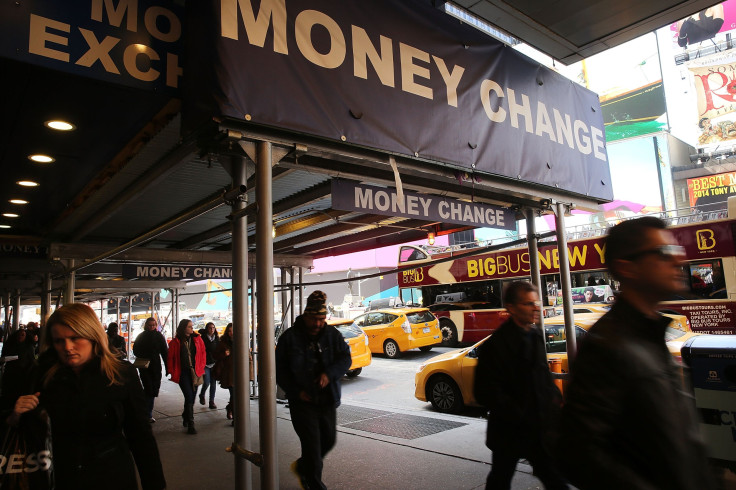Strong Dollar Means Slowed Growth For International Visitors To The US

The world flocked to visit the United States in record numbers in 2014: Some 75 million international visitors landed on American soil, according to data from the U.S. Department of Commerce. And they’re probably glad they did -- because a trip to the U.S. has gotten a lot more expensive for them in the last year.
That’s because the U.S. dollar is sitting pretty against a basket of international currencies like the Euro right now. One euro is worth about $1.10, down 20 percent from a year ago. And while that’s great news for Americans traveling abroad, it’s not so good for other nationalities who want to see the Statue of Liberty or the Golden Gate Bridge. As the dollar remains strong and the global economy remains in a relatively slow growth period, economists expect the growth of international visitors to the U.S. to fall, and that those tourists who come will spend less money while they’re there.
“We don’t expect U.S. inbound travel to fall substantially in 2015 as a result of these forces,” said Adam Sacks, economist and president of consulting firm Tourism Economics. “But our models do indicate a sharp slowdown in growth.”
According to a Tourism Economics report, Marriott International CEO Arne Sorenson noted a slight decline in room rentals from Europeans in the first quarter of 2015. Starwood Hotels also saw a decrease in forward bookings, indicating a potential drop in demand for international visitors during the third quarter, the main summer leisure travel period.
In an analysis by Sacks of Tourism Economics, a 10 percent appreciation of the dollar typically accounts for a reduction of 2 percent in international inbound visitors. “The dollar is about 20 percent stronger over the euro than it was last year,” he said. “That implies a 4 percent pullback of visitors from the Eurozone. That’s significant, but it’s not a full off-the-edge-of-a-cliff situation.” (The Eurozone includes 19 countries, among them traditional sources of heavy tourist inflows to the U.S. like Germany, France and Italy.)
The last time the Euro was at parity with the dollar, in 2000, visits to the U.S. from the Eurozone declined about 2 percent. “That was when the euro had declined 13 percent in value," said Sacks. "So it’s consistent with what our model tells us -- that a 10 percent change in currency causes a 2 percent decrease in inbound visitors.”
Then there's the effect of economic growth on tourism. For example, Chinese tourism to the U.S. has been explosive over the last four years, growing at about 25 percent each year. But this year, it’s expected to decrease to about 13 percent growth, thanks to a Chinese economy that’s also slowing down.
The major difference, said Sacks, is how much those visitors will spend when they get here. According to data from the U.S. Bureau of Economic Analysis, spending by international travelers in the U.S. grew by just 0.9 percent in the first quarter of 2015.
“In the first quarter, spending was relatively flat [compared] to last year. That indicates that yield per visitor will also be constrained moving through the year,” said Sacks. “People won’t be buying quite as many iPads and jeans and all the things that visitors tend to go home with when they visit.”
Visitors may also cut their trips short to compensate for a more expensive climate, said David Huether, senior vice president for research at the U.S. Travel Association.
“International travelers still want to come to the U.S., but because the ‘U.S. product’ is more expensive, they adjusted their spending habits by either shortening their stay or spending less at retail establishments,” he said.
New York City, whose economy relies heavily on international tourists, still expects about 58.1 million visitors this year, up from 56.4 million in 2014. Some of that, experts say, could be due to an uptick in domestic travel from Americans themselves, which is expected to be at a high this summer thanks to an improving economy.
NYC & Company, the city’s tourism and marketing agency, is bracing for international visitors to spend less than in years past.
“The strong dollar is unlikely to dampen the number of visitors New York City welcomes, but it could impact their in-market spending,” said NYC & Company spokeswoman Dana Libner. “A tourist who may have purchased three pairs of shoes might only purchase two now.”
That’s true for Rosa and Ibai Aramburu of Cervera, Spain, who were visiting New York City for a week in May. They’re keeping an eye on their spending, noting that everything from restaurants to museum entrance prices seem sky-high -- and more than they expected. The couple says the only way they were able to afford the trip is thanks to a friend of Rosa’s who lives in the city and offered a free place to stay.
They planned the trip three months ago, when they learned that their friend only had a few months left in the city. “Each week it seems to get more expensive,” said Rosa. “If it wasn’t for my friend, we wouldn’t have been able to come.”
NYC & Company wants visitors like the Aramburus to know that there are plenty of ways to enjoy the Big Apple without spending an arm and a leg through its new “Free In NYC” campaign this summer.
“We know that some visitors think a visit to New York City is necessarily expensive,” said Libner. “We want them to know that’s not the case at all -- there are innumerable free and affordable ways to experience New York City’s energy, culture and cuisine.”
© Copyright IBTimes 2025. All rights reserved.





















